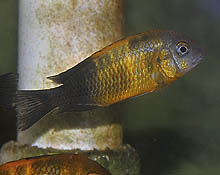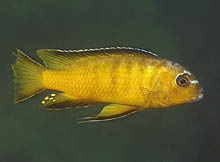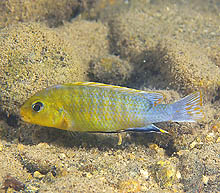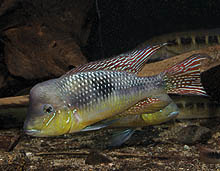WHAT'S NEW ACROSS THE WORLD
Select date in side bar to go a What's
New of previous issues
| What's New ©by
Laif DeMason
As this winter draws to its end and the signs
of spring slowly appear, many aquarists start to rethink their fish rooms.
Spring cleaning also applies to aquaria! It is time to clean up and reorganize
those tanks that need help. Round up those extra fry and take them to the
local retailer or aquarium club. While there, look around for some interesting
cichlids to take home. Tear down those aquaria that are just in a holding
pattern and reset them up in a more functional way with new fish. Shop
around and also find out what your hobbyist friends are doing. It is spring
cleaning time!
Here’s “what’s new” on the cichlid scene: |
Lake Tanganyika
Collections continue around Lake Tanganyika, although wild caught fishes
from the Congo coast seem to be fewer and farther between. Interestingly,
Burundi has come up with new wild items, previously not yet seen even though
that country has the least amount of rocky coastline. It just goes to show
that if one looks carefully, new items may appear!
|
what's new: Lake Tanganyika
|

A special population of Neolamprologus leleupi
from Luhanga, Congo has excellent orange coloration and was recently
re-exported from Burundi. It was first shipped by Pierre Brichard in the
1970s and appeared on the cover of his famous Lake Tanganyika fish book. |

Also from Burundi, is the rarely exported Ctenochromis
benthicola. As one can see, this dark form of the fish still sports
blue-white body flecks and fin highlights along with yellow markings.
|

On the surface, this Tropheus looks like the
normal Kiriza (Kaiser II) form. However, this form, sold as “black” or
“black wag” because of its darker black markings, produces the highly desired
Kaiser Gold form in about a quarter of their progeny. |

Unusual Petrochromis species continue to dribble
in. Here a P. sp. “macrognathus rainbow” which is found around the
Kipili, Tanzania area and northwards. As the “rainbow” label indicates,
this species is a colorful version of the typical P. macrognathus, sporting
red fins. To my knowledge, this is the first time this fish was imported
into the USA.
|
Lake Malawi
Shipments of wild caught material from Lake Malawi seemingly had a slow
start in 2008. Most of January saw little action through export permit
delays and the loss of the late Stuart Grant. However, the good news is
that the Grant compound is up and running with good selection and arrivals.
Far off collection points such as many places in Mozambique are largely
cost prohibitive now due to ever increasing fuel costs and shortages. This
means that collecting items like the Red Zebra is no longer profitable!

Exported from Malawi recently, Aulonocara sp.
yellow collar Mazinzi Reef is collected near Monkey Bay, Malawi and the
first photograph of this species was published in Ribbink’s 1983 book. |

Newly collected in Charo, Malawi, Cynotilapia afra
Charo is a large afra form sporting the typical white top colors along
with gold colored posterior dorsal fin and caudal fin flecks. |

A zebra type from Nkhomo Reef, Malawi, Metriaclima
cyneusmarginatus exhibits the striking barring and gold fin highlights
also seen in the long-time favorite Chilumba Zebra. |

Infrequently exported in the past, Otopharnyx sp.
“spots” Chia Lagoon arrives sparingly in shipments from time to time. Its
basic color pattern is quite unlike any other cichlid that comes to mind.
Photo by A. Konings. |

Found only at two reefs, Mara Rocks and Tchinga Reef,
both near Usisya along the northwestern shore of the lake, Metriaclima
sp. “elongatus usisya” is one of the most attractive of the slender mbuna.
Photo by A. Konings. |

Pseudotropheus perspicax occurs in many different
geograpical variants, but only near Usisya do we find yellow to orange
color in the male breeding dress. Photo by A. Konings. |
Lake Victoria
Wild material exported from the Mwanza Gulf areas in Tanzania has slowed
considerably. Some logistics in collecting and transport remain to be solved.
Thus, each venture leads to monetary losses for the exporter. A few small
shipments dribbled out in December last year; however, more collections
seem to be doubtful at present—unfortunate news for all the Victorian cichlid
fans.
|
what's new: Lake Victoria
|

A few individuals of wild Neochromis omnicaeruleus
(blue scraper) were imported into the United States and Europe. There are
several color morphs naturally occurring in Lake Victoria. Pictured here
is the standard coloration for a male. |

Some of the female N. omnicaeruleus recently
imported were of the black OB color form. Pictured here is a black OB or
piebald female. Other females were grey-blue with light bars. |
Neotropics
The export of wild material from South America started a bit slow this
year, but availability and varieties of wild caught items has increased
over the last months. Between the seasonal items such as pike cichlids,
and the many special bred items, such as Cichlasoma and Geophagus
types, there are many species to choose from. However, there are spotty
shortages of common cichlids, like convicts and Jack Dempseys, due to the
Florida freeze on January 3rd.

From the Rio Uruguay in Argentina’s Missiones Province,
Crenicichla missioneira is a great looking fish. It is also part
of a species complex of about one dozen pike cichlids from that region.
Photo by O. Lucanus. |

Argentina and Uruguay continue to surprise us with
dozens of new varieties and species of Gymnogeophagus. Here is a
beautiful G. gymnogenys. These medium sized cichlids do well in
larger tanks. Photo by O. Lucanus. |

For the first time in years, a few individuals of
‘Cichlasoma’ atromaculatum were collected and shipped from
the Rio Atrato in the western Andeans in Columbia. Hopefully this placid
cichlid will become well established in the hobby this time. Photo by O.
Lucanus. |

Another pike cichlid, Crenicichla hadrostigma,
is a dwarf pike from the Rio Uruguay as well. It was only described last
year. Adults show bright green colors and a large black spot above the
gill plate, making it a good selection for pike cichlid fans. Photo by
O. Lucanus. |
Select date in side bar to go a What's
New of previous issues
|















